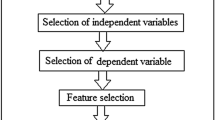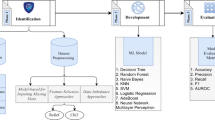Abstract
This study attempts to propose a predictive analytics approach for the prediction of the potential odds of developmental stuttering in preschool-aged children. This approach would yield better and more accurate results for the whole population of children. The publicly available dataset from Vanderbilt University was chosen to acquire research-based historical temperamental data on both children who stutter (CWS) and children who not stutter (CWNS). Machine learning (ML) algorithm, called, Logistic Regression has been implemented for the prediction purpose. The outcomes of this study suggest that the temperamental parameters of CWS and CWNS can be utilized to predict the potential risk of odds of developmental stuttering. The role of feature selection algorithms was found to be very decisive for generating optimal prediction results with a minimal number of features. Data re-sampling technique such as SMOTE was found to be very productive to generate synthetic data observations for minority classes like CWS. The research-based historical data of developmental stuttering is a precious treasure. On such data, predictive modeling can be applied to explore hidden patterns and the causation-and-effect relationships between data variables concerning stuttering. The outcomes of this study may benefit several stakeholders like Researchers, Therapists, SLPs, and Consultants who offer professional services for the advancements in the area of fluency.







Similar content being viewed by others
Notes
Available at: https://vkc.mc.vanderbilt.edu/childhoodstuttering/files/Vanderbilt_DSP_data.xlsx.
Description File: https://vkc.mc.vanderbilt.edu/childhoodstuttering/files/Vanderbilt_DSP_Description.pdf.
Definitions File: https://vkc.mc.vanderbilt.edu/childhoodstuttering/files/Vanderbilt_DSP_definitions.pdf.
We considered it is as dependent variables that represents Talker Group based on Stuttering Severity Instrument, 0 = CWNS (SSI_total < 11); 1 = CWS (SSI_total >= 11), where SSI_total is total score of Stuttering Severity Instrument that includes sum of scaled scores for frequency of stuttering + duration of stuttering + physical concomitants.
References
Achenbach TM (1991) Manual for the child behaviour checklist: 4–18 and 1991 profile.
Alpaydin E (2004) Introduction to machine learning. MIT Press, Cambridge
Anderson JD, Pellowski MW, Conture EG, Kelly EM (2003) Temperamental characteristics of young children who stutter. J Speech Lang Hear Res 46(5):1221–1233
Berchiattia M, Badenes-Ribera L, Ferrer A, Longobardi C, Gastaldib FGM (2020) School adjustment in children who stutter: The quality of the student-teacher relationship, peer relationships, and children’s academic and behavioral competence. Child Youth Serv Rev. https://doi.org/10.1016/j.childyouth.2020.105226
Bishop CM (2006) Pattern recognition and machine learning. Springer, New York
Burnham KP, Anderson DR (2002) Model selection and multimodel inference: a practical information-theoretic approach, 2nd edn. Springer, New York
Busan P (2020) Developmental stuttering and the role of the supplementary motor cortex. J Fluency Disord 64:105763
Bush A (2006) Effects of childhood stuttering on attention regulation in emotionally arousing situations. Vand Undergrad Res J 2(1):1–14
Caspari SS, Strand EA (2007) Overview of session obstructive sleep apnea (OSA) neuropsychological and motor deficits associated with OSA language and OSA? General intelligence unaffected by OSA speech and OSA?. Presented at the Evidence of abnormal speech profiles in. pp 1–27 Accessed 29 May 2020
Chawla NV, Bowyer KW, Hall LO, Kegelmeyer WP (2002) SMOTE: synthetic minority over-sampling technique. J Artif Intel Res 16:321–357
Chmela K, Johnson L (2018) How can we overcome the challenges of providing school-based fluency services? Semi Speech Lang 39(4):371–381
Choi D, Conture EG, Tumanova V, Clark CE, Walden TA, Jones RM (2018) Young children’s family history of stuttering and their articulation, language and attentional abilities: an exploratory study. J Commun Disord 71:22–36
Choo AL, Smith SA (2020) Bilingual children who stutter: convergence, gaps and directions for research. J Fluen Disord 63:105741
Costello EJ, Mustillo S, Erkanli A, Keeler G, Angold A (2003) Prevalence and development of psychiatric disorders in childhood and adolescence. Arch Gen Psych 60:8
Dixon WE, Shore C (1997) Temperamental predictors of linguistic style during multiword acquisition. Infant Behav Develop 20(1):99–103
Eggers K, De Nil LF, den Bergh BRHV (2010) Temperament dimensions in stuttering and typically developing children. J Fluency Disord 35(4):355–372
Einarsdóttir JT, Crowe K, Kristinsson SH, Másdóttir T (2020) The recovery rate of early stuttering. J Fluency Disord 64:105764
Eisenberg N, Fabes RA, Bernzweig J, Karbon M, Poulin R, Hanish L (1993) The relations of emotionality and regulation to preschoolers’ social skills and sociometric status. Child Develop 64(5):1418
Erdemir A, Walden TA, Jefferson CM, Choi D, Jones RM (2018) The effect of emotion on articulation rate in persistence and recovery of childhood stuttering. J Fluency Disord 56:1–17
Frigerio-Domingues CE, Gkalitsiou Z, Zezinka A, Sainz E, Gutierrez J, Byrd C, Webster R et al (2019) Genetic factors and therapy outcomes in persistent developmental stuttering. J Commun Disord 80:11–17
Goldsmith HH, Buss AH, Plomin R, Rothbart MK, Thomas A, Chess S, Hinde RA et al (1987) Roundtable: what is temperament? Four approaches. Child Develop 58(2):505
Hair JF, Black WC, Babin BJ, Anderson RE (2014) Multivariate data analysis, 7th edn. Pearson, Harlow
Han J, Kamber M, Pei J (2001) Data mining: concepts and techniques, 3rd edn. Morgan Kaufmann Publishers, San Francisco
ICD (2020) ICD-10-CM codes. https://www.icd10data.com/ICD10CM/Codes/F01-F99/F80-F89/F80-/F80.81
Iverach L, Jones M, McLellan LF, Lyneham HJ, Menzies RG, Onslow M, Rapee RM (2016) Prevalence of anxiety disorders among children who stutter. J Fluency Disord 49:13–28
Johnson KN, Walden TA, Conture EG, Karrass J (2010) Spontaneous regulation of emotions in preschool children who stutter: preliminary findings. J Speech Lang Hear Res 53(6):1478–1495
Jones R, Choi D, Conture E, Walden T (2014a) Temperament, emotion, and childhood stuttering. Semin Speech Lang 35(2):114–131
Jones RM, Conture EG, Walden TA (2014b) Emotional reactivity and regulation associated with fluent and stuttered utterances of preschool-age children who stutter. J Commun Disord 48:38–51
Karrass J, Walden TA, Conture EG, Graham CG, Arnold HS, Hartfield KN, Schwenk KA (2006) Relation of emotional reactivity and regulation to childhood stuttering. J Commun Disord 39(6):402–423
Kaushik (n.d.) Feature selection methods with example (variable selection methods). Anal Vidhya. https://www.analyticsvidhya.com/blog/2016/12/introduction-to-feature-selection-methods. Accessed 29 May 2020
Kefalianos E, Onslow M, Ukoumunne OC, Block S, Reilly S (2017) Temperament and early stuttering development: cross-sectional findings from a community cohort. J Speech Lang Hear Res 60(4):772–784
Kyrios M, Prior M (1990) Temperament, stress and family factors in behavioural adjustment of 3-5-years-old children. Int J Behav Develop 13(1):67–93
Maguire GA, Yeh CY, Ito BS (2012) Overview of the diagnosis and treatment of stuttering. J Exp Clin Med 4(2):92–97
Mcdevitt SC, Carey WB (1978) The measurement of temperament in 3–7 year old children. J Child Psychol Psych 19(3):245–253
Ntourou K, Conture EG, Walden TA (2013) Emotional reactivity and regulation in preschool-age children who stutter. J Fluency Disord 38(3):260–274
Ntourou K, DeFranco EO, Conture EG, Walden TA, Mushtaq N (2020) A parent-report scale of behavioral inhibition: validation and application to preschool-age children who do and do not stutter. J Fluency Disord 63:105748
Rieser-Danner LA (2003) Individual differences in infant fearfulness and cognitive performance: a testing, performance, or competence effect? Genetic Social Gen Psychol Monogr 129(1):41–71
Riley GD, Riley J (1979) A component model for diagnosing and treating children who stutter. J Fluency Disord 4(4):279–293
Rocha MS, Yaruss JS, Rato JR (2019) Temperament, executive functioning, and anxiety in school-age children who stutter. Front Psychol 10:2244
Rothbart M, Derryberry D (1981) Development of individual differences in temperament
Rothbart MK, Ahadi SA, Evans DE (2000) Temperament and personality: Origins and outcomes. J Person Soc Psychol 78(1):122–135
Sanson AS, Hemphill A, Smart D (2004) Connections between temperament and social development: a review. Blackwell Publishing Ltd, Oxford
Schwenk KA, Conture EG, Walden TA (2007) Reaction to background stimulation of preschool children who do and do not stutter. J Commun Disord 40(2):129–141
Stuttering Foundation (2020) How many children stutter? Stutt Found Soc. https://www.stutteringhelp.org/faq.
Usler ER, Weber C (2021) Emotion processing in children who do and do not stutter: an ERP study of electrocortical reactivity and regulation to peer facial expressions. J Fluency Disord 67:105802
Wagovich S, Julie A, Hill M (2020) Visual exogenous and endogenous attention and visual memory in preschool children who stutter. J Fluency Disord 66:105792
Waheed SA, Abdul Khader PS (2020) IoT based approach for detection of dominating emotions in persons who stutter. In: Proceedings of the 2020 Fourth International Conference on I-SMAC (IoT in Social, Mobile, Analytics and Cloud) (I-SMAC), presented at the 2020 Fourth International Conference on I-SMAC (IoT in Social, Mobile, Analytics and Cloud) (I-SMAC), IEEE, Palladam, India, pp 14–18.
Waheed SA, Sheik Abdul Khader P (2017) A novel approach for smart and cost effective IoT based elderly fall detection system using Pi camera. In: Proceedings of the 2017 IEEE International Conference on Computational Intelligence and Computing Research (ICCIC), presented at the 2017 IEEE International Conference on Computational Intelligence and Computing Research (ICCIC), IEEE, Coimbatore, pp 1–4.
Walden TA, Frankel CB, Buhr AP, Johnson KN, Conture EG, Karrass JM (2013) Dual Diathesis-stressor model of emotional and linguistic contributions to developmental stuttering. J Abnorm Child Psychol 40:633–644
Yairi E, Seery CH (2015) Stuttering: foundations and clinical applications. Pearson, Upper Saddle River
Zengin-Bolatkale H, Conture EG, Key AP, Walden TA, Jones RM (2018) Cortical associates of emotional reactivity and regulation in childhood stuttering. J Fluency Disord 56:81–99
Author information
Authors and Affiliations
Corresponding author
Additional information
Publisher's Note
Springer Nature remains neutral with regard to jurisdictional claims in published maps and institutional affiliations.
Rights and permissions
About this article
Cite this article
Abdul Waheed, S., Abdul Khader, P.S. A machine learning approach for managing the potential risk of odds of developmental stuttering. Int J Syst Assur Eng Manag (2021). https://doi.org/10.1007/s13198-021-01151-6
Received:
Revised:
Accepted:
Published:
DOI: https://doi.org/10.1007/s13198-021-01151-6




